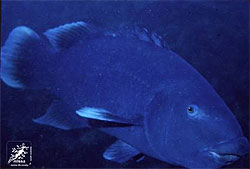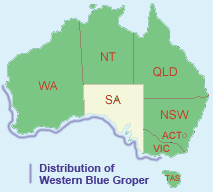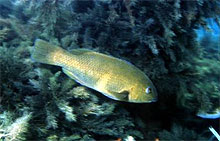Western Blue Groper
Major Source: Marine Life Society of South Australia Inc

Adult Western Blue Groper
|
Western Blue Gropers are long-lived and slow growing, taking 15 years to reach sexual maturity at 60 cm.
They are thick bodied with peg shaped teeth, large scales and tail and thick lips. Juvenile Western Blue Gropers range from brown to green brown in colour. Adult females are mainly a dull green colour, some are brown ranging through to red grey. The adult males colouring ranges from deep navy to cobalt blue.
Western Blue Gropers are in the “Bony fish” group, this group makes up the majority of fish. Their skeletons are partly made of bone; they have thin, overlapping scales covered with mucus and a ‘swim bladder’ which stops them from sinking in the water by adjusting the amount of air in the bladder. |
 |
| |
|
|
The Western blue groper is found from near Geraldton in Western Australia to west of Melbourne. The fish live in a variety of coastal waters, especially exposed reefs. The Western blue groper lives in water from 5 to 65 m deep.
In South Australia, Western blue gropers used to be common throughout Investigator Strait, and on the southern coast of Yorke Peninsula, but adults have not been seen on southern Yorke Peninsula since the 1960s when they were fished out. They still occur on northern Kangaroo Island due to their protection in the gulfs.
|
| Kingdom: |
Animalia |
| Phylum: |
Chordata |
| Class: |
Actinopterygii |
| Order: |
Perciformes |
| Family: |
Labridae |
| Genus: |
Achoerodus |
| Species: |
Achoerodus gouldii |
|
|
| |
IUCN Red List - Lower Risk (conservation dependent).
Western Blue Groper numbers have decreased in recent years. This is mostly due to heavy fishing and spearfishing pressure and the ease of capture of these fish because of their large size, good taste and their inquisitive behaviour.
Western blue gropers have a strong population structure and they change sex with age so fishing can disrupt population structure and dynamics.
Given its longevity and diet, Western blue gropers may be a “keystone” species in the reef habitats where it occurs, and there may be ecological cascade effects from the extirpation of groper from reefs.
|

Juvenile Western Blue Groper
|
The questions regarding protection of the blue groper raise welfare issues which have been considered extensively in recent years, and has been well reviewed in Huntingford et al. (2006) J. Fish Biol. 68, 332-372.
It was concluded that conditions that produce unacceptable levels of anxiety, fear, stress, sickness, pain ...etc in fish should be minimised.
more ... |
|




